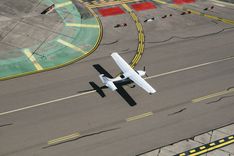Estonian Air Navigation Services (EANS) in cooperation with Estonian leading software developer Cybernetica introduced a remote tower solution that enables to control air traffic at several aerodromes simultaneously in the World ATM Congress 2019 in Madrid.
“Remote tower is a short-range air traffic control solution, where the visual presentation of the area of responsibility is received via cameras located at aerodromes, transferred via fiber optic cables and presented on a panoramic screen at a working position called a remote tower module. This means that the air traffic controller does not have to be located in the immediate proximity of the aerodrome,” introduced Üllar Salumäe, the Member of the Management Board of EANS. He added that the visual reproduction can be overlaid with information from additional sources like surveillance equipment and infrared cameras, so the visual reproduction will be enhanced with the help of different technical solutions to support situational awareness in case of different light and visibility conditions. According to Salumäe, such an approach creates the opportunity to simultaneously manage air traffic at several aerodromes and to provide a more cost-effective, yet high-quality service.
One leading remote tower centre
The development of the remote tower started in September 2016 in cooperation with Estonian leading software developer Cybernetica, which has extensive experience in developing surveillance solutions for vessel traffic services and video monitoring for port operations. The aim was to develop a remote tower air traffic control solution that would meet the reality of Estonian market. “As there is only one major aerodrome and four regional aerodromes in Estonia, it is not practical to use different systems for air traffic control, but to transfer regional aerodromes to a single air traffic control system. The existence of a remote tower is a prerequisite for the switch,” explained Salumäe. Although the system was initially designed for Estonian air traffic control, it can be easily used by any nation or company.
According to Martin Link, Cybernetica’s Head of Sales for Communications and Surveillance Systems , the greatest advantage of the remote tower is open architecture, which provides the opportunity to customize the remote tower solution to the needs of any company or country in the world. "In addition, it is possible to integrate the system with other software systems or to use the solution as a basis for developing your own specific system, making it all more cost-effective than current air traffic control alternatives, " said Link. Furthermore, the technology is developed in a way that there will be no need for major changes in operational working methods of air traffic services personnel.
System development has involved aviation and IT experts to ensure maximum system security. “During the development process, we have tested various high-tech solutions and their suitability for day-to-day real-life air traffic control situations with the Estonian Aviation Academy and Estonian Air Navigation Services, thereby ensuring the highest quality and air safety,” Link highlighted. At the moment, prototype development and system certification are underway.
Furthermore, EANS and Cybernetica would like to develop the remote tower solution into a remote tower center air traffic control facility that enables a central and flexible provision of air traffic services simultaneously to multiple aerodromes from one work station. “An innovative air traffic control system like RTC would help regional aerodromes to make more (cost)efficient use of labour, yet still ensure highest quality of air traffic control and safety,” explained Salumäe, saying that in Europe, the leading users of remote towers are Norway and Sweden, where small airports are often controlled via remote tower. He believes that RTC solution will be one of the key solutions in the future of air traffic control.
